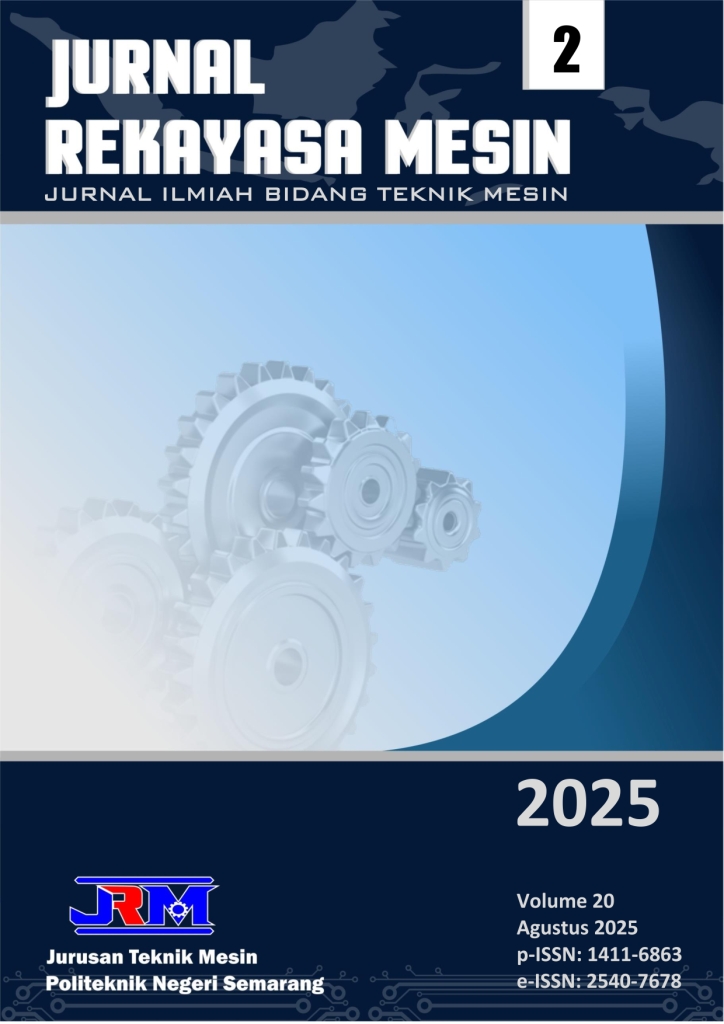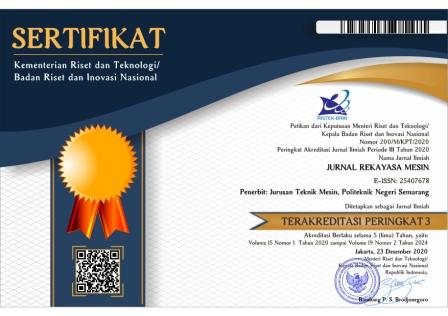Prosthetic Foot Mold Making with Photogrammetry Based Reverse Engineering Method
DOI:
https://doi.org/10.32497/jrm.v20i2.6276Keywords:
Cetakan telapak kaki prostetik, Reverse engineering, Photogrammetry, Desain CADAbstract
Prosthetic foot mold making is a crucial stage in the production of prosthetic feet that are in accordance with the anatomy and user needs. This research aims to develop a method for making prosthetic foot mold using a reverse engineering approach with photogrammetry techniques. The process begins with scanning the sole of the foot using photogrammetry methods to obtain a three dimensional model. The scanned model is then converted into a CAD design which is used as the basis for mold making. The mold design was made by considering ergonomic aspects and ease of manufacturing in the next stage. The results showed that the average deviation was within the range of ±0.65 mm or 0.42%, with a maximum deviation of 1.42%. This method is capable of producing precise casts that match the geometry of the original foot. With this approach, it is expected to improve the quality and customization of prosthetic products in the future.
References
M. S. Dani Prastiwi, S.Kep., Ns. et al., Pengantar Biomedik Panduan Komprehensif, vol. 01. 2023.
I. A. Gujarathi, M. Zahabi, Z. J. Pei, and A. E. Patterson., Decision-Making Framework for Customized Additively-Manufactured Lower-Limb Prosthetics. 2024 Agustus; p. 181”“207.
T. Pereira, J. V. Kennedy, and J. Potgieter., A comparison of traditional manufacturing vs additive manufacturing, the best method for the job. Procedia Manufacturing. 2019; 30. p. 11”“18.
N. A. and A. V. Rui Silva, Bruna Silva, Cristiana Fernandes, Pedro Morouço., A Review on 3D Scanners Studies for Producing Customized Orthoses. Sensors. 2024 Februari; 24(5). p. 1-19.
K. IsteniÄ, N. Gracias, A. Arnaubec, J. EscartÃn, and R. Garcia., Scale accuracy evaluation of image-based 3D reconstruction strategies using laser photogrammetry. Remote Sens. 2019 Juli; 11(18). p. 1-32.
J. Barrios-Muriel, F. Romero-Sánchez, F. J. Alonso-Sánchez, and D. R. Salgado., Advances in orthotic and prosthetic manufacturing: A technology review. Materials (Basel). 2020 Januari; 13(2). p.1-15.
A. A. I. Al-kharaz., 3D Photogrammetric Images To Evaluate Foot Morphology And Ankle Kinematic During Gait Of Middle Eastern Adults. Australia University of Southern Queensland; 2021. p.163
S. Cullen, R. Mackay, A. Mohagheghi, and X. Du., The use of smartphone photogrammetry to digitise transtibial sockets: Optimisation of method and quantitative evaluation of suitability. Sensors. 2021 Desember; 21(24), p. 1-16
R. Ismail et al., Affordable and Faster Transradial Prosthetic Socket Production Using Photogrammetry and 3D Printing. Electronics. 2020 September; 9(9), p. 1-11.
A. Dickinson et al., Selecting Appropriate 3D Scanning Technologies for Prosthetic Socket Design and Transtibial Residual Limb Shape Characterisation. Journal of Prosthetics and Orthotics. 2022 Januari; 34(1). p.33-43.
I. Sanz-Pena, S. M. Arachchi, N. Curtis-Woodcock, P. Silva, A. H. McGregor, and N. Newell., Obtaining Patient Torso Geometry for the Design of Scoliosis Braces. A Study of the Accuracy and Repeatability of Handheld 3D Scanners. Prosthetics and Orthotics International. 2022 Agustus; 46(4). p. e374”“e382.
A. V Vasiliadis, N. E. Koukoulias, and K. Katakalos., From Three-Dimensional (3d)- To 6d-Printing Technology in Orthopedics: Science Fiction or Scientific Reality. J. Funct. Biomater. 2022 Juli; 13(3). p. 1-16.
Medina, J. J., Maley, J. M., Sannapareddy, S., Medina, N. N., Gilman, C. M., & McCormack, J. E., A rapid and cost-effective pipeline for digitization of museum specimens with 3D photogrammetry. PLoS ONE. 2020 Agustus; 15(8). p.1”“14.
Priyambodo, D. Y., Aplikasi Fotogrametri untuk Pemeriksaan Kerangka. Plexus Medical Journal, 2022 Agustus; 1(4). p.122”“129.
Dabove, P., Grasso, N., & Piras, M., Smartphone-based photogrammetry for the 3D modeling of a geomorphological structure. Applied Sciences (Switzerland), 2019 September; 9(18). p.1-20.
Downloads
Published
How to Cite
Issue
Section
License
Copyright (c) 2025 Muhammad Arif Hidayat, Wahyu Dwi Lestari

This work is licensed under a Creative Commons Attribution-NonCommercial-ShareAlike 4.0 International License.
Copyright of articles that appear in Jurnal Rekayasa Mesin belongs exclusively to Penerbit Jurusan Teknik Mesin Politeknik Negeri Semarang. This copyright covers the rights to reproduce the article, including reprints, electronic reproductions, or any other reproductions of similar nature.







